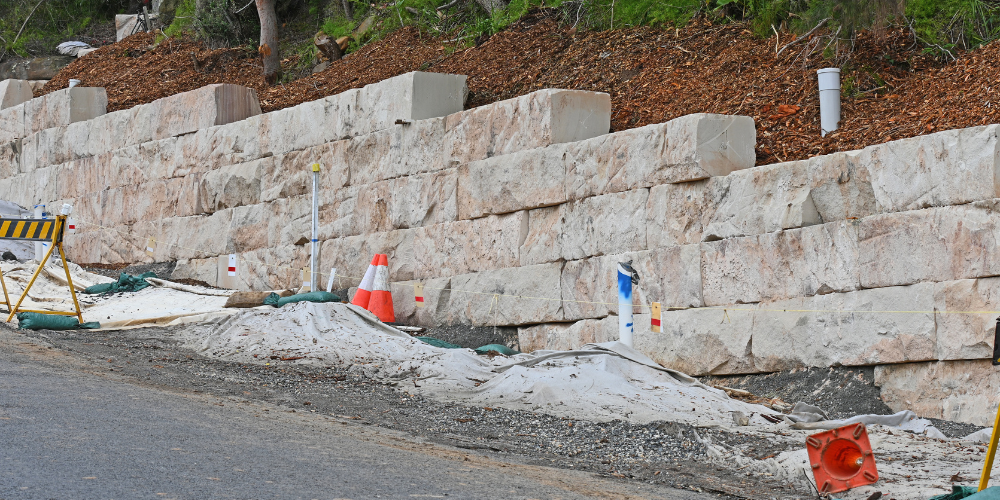So, you’ve got a sloping yard, and every time it rains, you’re half-expecting Noah’s Ark to show up. It’s time to talk retaining walls and erosion control. Not only are these structures crucial for preventing your yard from turning into a muddy disaster, but they also add some serious curb appeal. Let’s dive into why retaining walls are the unsung heroes of landscape design and how they keep erosion at bay.
Key Takeaway: Retaining walls are essential for controlling erosion and protecting your property from damage. They provide both functional support and aesthetic value, making them a must-have for any landscape with elevation changes.
The Basics of Retaining Walls
Types of Retaining Walls, Materials Used, and Basic Construction Principles
Retaining walls aren’t just pretty barriers. They’re engineering marvels designed to hold back soil and prevent erosion. There are various types of retaining walls, including gravity walls, cantilevered walls, and anchored walls. Each type serves a different purpose and is made from materials like concrete, stone, brick, or even timber.
Types of Retaining Walls: Gravity walls rely on their own weight to hold back soil, while cantilevered walls use a structure extending into the ground for support. Anchored walls, the overachievers of the group, use cables or other supports anchored into the rock or soil behind them.
Materials Used: Concrete and stone are popular for their durability, while timber is chosen for a more natural look. Each material has its pros and cons, but the choice often comes down to budget and aesthetic preference.
Basic Construction Principles: Regardless of type or material, all retaining walls must be designed to manage water drainage effectively. Poor drainage can lead to wall failure, turning your property into a DIY disaster show.
Erosion Control Techniques
Proper Drainage, Vegetation, and Erosion Control Fabrics
Erosion control isn’t just about building walls. It’s about managing water flow and stabilizing the soil.
Proper Drainage: Installing drainage pipes or gravel behind the retaining wall ensures that water doesn’t build up and push against the wall. It’s like giving your wall a pressure relief valve.
Vegetation: Planting grass, shrubs, or ground cover helps stabilize the soil. Roots hold the soil together, reducing erosion. Plus, it adds some green to your landscape, which is always a win.
Erosion Control Fabrics: These are placed over soil to prevent erosion. They’re like the Spanx of landscaping—keeping everything tight and in place while water passes through.
Why Retaining Walls Fail
Poor Design, Inadequate Drainage, and Lack of Maintenance
Even the best retaining walls can fail if they’re not properly designed, installed, and maintained.
Poor Design: A retaining wall isn’t a weekend DIY project. Poorly designed walls can’t handle the load, leading to cracks and collapses. Hiring a professional is key to ensuring your wall can withstand the forces of nature.
Inadequate Drainage: Water is the enemy. Without proper drainage, water pressure builds up behind the wall, leading to failure. Think of it as a ticking time bomb—except it’s water and soil instead of explosives.
Lack of Maintenance: Retaining walls require regular check-ups. Ignoring small cracks or drainage issues can lead to bigger problems down the road. It’s like ignoring a check engine light in your car—never a good idea.
Designing for Aesthetic Appeal
Incorporating Curves, Using Decorative Materials, and Adding Lighting
Retaining walls don’t have to be eyesores. They can enhance your landscape’s beauty.
Incorporating Curves: Straight walls are functional, but curved walls add a touch of elegance and blend better with natural landscapes. They’re like the difference between a straight line and a scenic route.
Using Decorative Materials: Stone veneers, bricks, and textured concrete can transform a plain wall into a work of art. It’s like upgrading from a basic car to a luxury model.
Adding Lighting: Landscape lighting can highlight your wall’s beauty and improve safety. Imagine your wall illuminated at night—practical and beautiful.
The Environmental Impact
Sustainable Materials, Eco-Friendly Designs, and Water Management
Your retaining wall can be both functional and environmentally friendly.
Sustainable Materials: Using recycled materials or locally sourced stone reduces the environmental footprint. It’s a win-win for you and Mother Earth.
Eco-Friendly Designs: Designing your wall to blend with the natural landscape minimizes environmental disruption. It’s like giving nature a hug.
Water Management: Properly managing water with your retaining wall prevents erosion and waterlogging, protecting nearby ecosystems. Think of it as being a good neighbor to nature.
Answering Common Questions:
Can I build a retaining wall myself?
While small walls can be DIY projects, larger walls require professional expertise to ensure they’re safe and effective.
How long do retaining walls last?
With proper design, materials, and maintenance, retaining walls can last decades, sometimes even longer.
What is the cost of building a retaining wall?
Costs vary based on materials, size, and complexity. It’s best to get a professional estimate to understand the full scope of the project.
–
Jefferie Ellison
Owner of Elite Foundation Repairs







